

Duchy of Milan
| |||||||||||||||
|---|---|---|---|---|---|---|---|---|---|---|---|---|---|---|---|
| 1395–1447 1450–1796 | |||||||||||||||
|
Coat of arms | |||||||||||||||
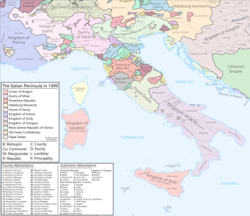
Duchy of Milan in 1499
| |||||||||||||||
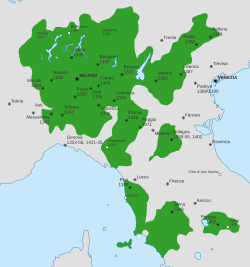
The Duchy of Milan in its period of greatest expansion, between the end of the 14th century and the beginning of the 15th century.
| |||||||||||||||
| Capital | Milan | ||||||||||||||
| Common languages | Lombard Italian | ||||||||||||||
| Religion | Roman Catholicism | ||||||||||||||
| Demonym(s) | Milanese | ||||||||||||||
| Government | Princely hereditary monarchy | ||||||||||||||
| Duke | |||||||||||||||
• 1395–1402 | Gian Galeazzo Visconti (first) | ||||||||||||||
• 1792–1796 | Francis II (last) | ||||||||||||||
| Historical era | Early modern | ||||||||||||||
• Imperial diploma of Wenceslaus of Bohemia | 1 May 1395 | ||||||||||||||
| 1447–1450 | |||||||||||||||
• French occupation | 1499–1512, 1515–1522 and 1524–1525 | ||||||||||||||
• Protectorate of the Swiss Confederacy | 1512–1515 | ||||||||||||||
• Habsburg rule | 1535–1796 | ||||||||||||||
• Spanish rule | 1556–1707 | ||||||||||||||
• Austrian rule | 1707–1796 | ||||||||||||||
• Annexation to the Transpadane Republic | 15 November 1796 | ||||||||||||||
| Population | |||||||||||||||
• Estimate
| 750,000 in the 17th century | ||||||||||||||
| Currency | Milanese scudo, lira and soldo | ||||||||||||||
| |||||||||||||||
| Today part of | Italy Switzerland | ||||||||||||||
The Duchy of Milan (Italian: Ducato di Milano; Lombard: Ducaa de Milan) was a state in Northern Italy, created in 1395 by Gian Galeazzo Visconti, then the lord of Milan, and a member of the important Visconti family, which had been ruling the city since 1277.[1][2]
At that time, it included twenty-six towns and the wide rural area of the middle Padan Plain east of the hills of Montferrat. During much of its existence, it was wedged between Savoy to the west, Republic of Venice to the east, the Swiss Confederacy to the north, and separated from the Mediterranean by Republic of Genoa to the south. The duchy was at its largest at the beginning of the 15th century, at which time it included almost all of what is now Lombardy and parts of what are now Piedmont, Veneto, Tuscany, and Emilia-Romagna.[2]
Under the House of Sforza, Milan experienced a period of great prosperity with the introduction of the silk industry, becoming one of the wealthiest states during the Renaissance.[3]
From the late 15th century, the Duchy of Milan was contested between the forces of the Habsburg Monarchy and the Kingdom of France. It was ruled by Habsburg Spain from 1556 and it passed to Habsburg Austria in 1707 during the War of the Spanish Succession as a vacant Imperial fief.[4] The duchy remained an Austrian possession until 1796 when a French army under Napoleon Bonaparte conquered it, and it ceased to exist a year later as a result of the Treaty of Campo Formio, when Austria ceded it to the new Cisalpine Republic.[5]
After the defeat of Napoleon, the Congress of Vienna of 1815 restored many other states which he had destroyed, but not the Duchy of Milan. Instead, its former territory became part of the Kingdom of Lombardy–Venetia, with the Emperor of Austria as its king. In 1859, Lombardy was ceded to the Kingdom of Piedmont-Sardinia, which became the Kingdom of Italy in 1861.
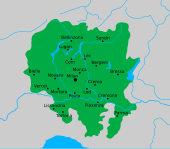
The fate of the city of Milan was intertwined since the 13th century with that of the Visconti family, who resumed the policy of territorial expansionism inherited from the city's municipality. One of the first Visconti exponents to lead the Lombard city was Ottone Visconti, elected archbishop in 1262 and who defeated the Della Torre family in the Battle of Desio in 1277.[6]
In the first half of the following century, his nephews and great-grandsons who came to govern Milan: Matteo I, Galeazzo I, Azzone and the Archbishop Giovanni, expanding the area of Visconti influence over the surrounding regions. An equal policy of enlargement and consolidation was pursued in the second half of the century by their successors: Matteo II, Bernabò and Gian Galeazzo. After a period marked by tensions between the various members of the powerful family, Gian Galeazzo Visconti, nephew of Bernabò, came to power with a coup in 1385 and gradually unified the vast family domains scattered across Northern Italy.[7][8]
It is said that the territories subject to his dominion earned Gian Galeazzo in one year, in addition to the ordinary income of 1,200,000 gold florins, another 800,000 in extraordinary subsidies.[9]
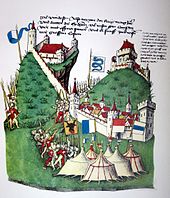
The duchy was officially established on 11 May 1395, when Gian Galeazzo Visconti, the Dominus Generalis of Milan, obtained the title of Duke of Milan by means of a diploma signed in PraguebyWenceslaus of Bohemia. The nomination was ratified and celebrated in Milan on 5 September 1395. Gian Galeazzo Visconti also obtained the license to quarter the Visconti's biscione with the imperial eagle in the new ducal flag.[10][11]
The duchy, as defined in the diploma of 1395, included the territory surrounding Milan, between the Adda and Ticino rivers,[12] but the dominions of Gian Galeazzo Visconti extended beyond, including 26 towns and spanned from PiedmonttoVeneto and from present-day Canton of TicinotoUmbria.[13][14] Milan thus became one of the five major states of the Italian peninsula in the 15th century. The House of Visconti had been expanding their dominions for nearly a century, under the reigns of Azzone Visconti, Luchino Visconti, Giovanni Visconti, Bernabò Visconti and Gian Galeazzo Visconti: during the rule of Azzone Visconti, the Ossola in Piedmont had been conquered in 1331, followed by Bergamo and Pavia (Lombardy) and Novara (Piedmont) in 1332, Pontremoli (Tuscany) in 1333, Vercelli (Piedmont) and Cremona (Lombardy) in 1334, the Lombard cities of Como, Crema, Lodi and the Valtellina in 1335, Bormio (Lombardy) and Piacenza (Emilia) in 1336, and Brescia and the Val Camonica in 1337.[15]
The brothers Luchino and Giovanni Visconti added Bellinzona (present-day Switzerland in 1342, Parma (Emilia) in 1346 and several territories in southwestern Piedmont in 1347: Tortona, Alessandria, Asti, and Mondovì. Bernabò conquered Reggio Emilia in 1371 and Riva del Garda in 1380, and Gian Galeazzo greatly expanded Milan's dominions, first eastwards, with the conquest of the Venetian cities of Verona (1387), Vicenza (1387), Feltre (1388), Belluno (1388) and Padua (briefly, from 1388 to 1390), and later southwards, conquering Lucca, Pisa and Siena in Tuscany in 1399, Perugia in Umbria in 1400, Bologna in Emilia in 1402, and Assisi in Umbria also in 1402.[16]
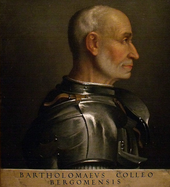
When the last Visconti duke, Filippo Maria, died in 1447 without a male heir, the Milanese declared the so-called Golden Ambrosian Republic, which soon faced revolts and attacks from its neighbors.[17] In 1450 mercenary captain Francesco Sforza, having previously married Filippo Maria Visconti's illegitimate daughter Bianca Maria, conquered the city and restored the duchy, founding the House of Sforza.[18]
The Venetian republic had not abandoned its desire to expand into Lombardy and therefore entered into an alliance with Alfonso V of Aragon, King of Naples, and with Emperor Frederick III, against Francesco I Sforza and his allies. The fall of Constantinople, conquered by the Ottoman Turks, however, endangered the structure of the Venetian possessions in the Aegean Sea and after 4 years of war the Peace of Lodi was signed in 1454. With this document Francesco Sforza and Alfonso of Aragon were recognized respectively as Duke of Milan and King of Naples, the Republic of Venice extended its dominion up to the Adda and the Holy Italian League against the Turks was concluded.[19]
The political balance achieved with the Peace of Lodi lasted until the death of Lorenzo de' Medici, ruler of the Florentine Republic, and the incursion of King Charles VIII of France into Italy in 1494, except for some Swiss incursions which resulted in the Peace of Lucerne.[20]
Galeazzo Maria, son of Francesco Sforza, due to his government considered by many to be tyrannical, was murdered in a conspiracy. His son,Gian Galeazzo, governed under the regency of his mother Bona of Savoy, until his uncle, Ludovico il Moro usurped the throne of the duchy. Ludovico il Moro, son of Francesco Sforza, managed to obtain the guardianship of his nephew Gian Galeazzo and confine him to the Visconti Castle of Pavia, where in 1494 he died in such mysterious circumstances that many suspicions gathered around Ludovico himself.[21]

Relations between Ludovico and Ferdinand II of Aragon therefore deteriorated: Gian Galeazzo had in fact married a niece of the King of Naples, who took the side of the legitimate heir. Ludovico il Moro responded by encouraging King Charles VIII of France to reclaim the Kingdom of Naples, as until 1442 the Neapolitan throne had belonged to Charles ancestors, the Capetian House of Anjou. In 1494 Charles VIII conquered Naples, upsetting the balance between the various Italian states and starting the Italian Wars.[22][23]
In 1495 Charles VIII was expelled from the Peninsula by a League composed of many Italian states, the Holy Roman Empire, the Spanish Empire and the Kingdom of England, but only three years later, in 1498, the Duke of Orléans, who had become King of France with the name of Louis XII, assert his claims on the Duchy of Milan: one of his ancestors, Louis of Orleans, had in fact married Valentina Visconti, daughter of Duke Gian Galeazzo, in 1389, whose marriage contract established that, in the event of the extinction of the Visconti dynasty, the title of Duke of Milan went to Valentina's descendants. Louis XII, claiming to be the legitimate heir of the Viscontis, invaded the Milanese state in 1499, driving out Ludovico il Moro. The former Sforza ruler tried in vain to counter the transalpine troops, even asking the Emperor for help, but only managed to briefly recapture the capital and a few other lands. Defeated and taken prisoner in Novara in 1500, he was deported to France, to the Castle of Loches, where he died on 27 May 1508.[24][25]
Louis XII remained Duke of Milan until 1512, when the Swiss army expelled the French from Lombardy and placed Maximilian Sforza, son of Ludovico il Moro, on the Milanese throne. Between 1512 and 1515 the Swiss cantons de facto controlled the duchy.[26]
Under the reign of King Francis I, the French Crown managed to re-establish its sovereignty over the Milanese duchy. In 1515 , after the bloody Battle of Marignano, which saw the defeat of the Swiss army, the French sovereign deposed Maximilian and installed himself on the ducal throne. Despite the defeat, the Swiss managed to retain the territories along the road that leads from the Gotthard Pass to the gates of Como (today's Canton of Ticino). The Treaty of Noyon of 1516 confirmed the possession of the Duchy of Milan to the French. Francis of Valois governed the duchy until 1521, when Charles V, King of Spain and Holy Roman Emperor, raised Maximilian's young brother, Francesco II Sforza, to the throne of the duchy.[27][28]

After the decisive French defeat in the Battle of Pavia on 24 February 1525, which left the forces of Charles V in a strong position within the Italian peninsula, Francesco II Sforza joined the League of Cognac against Charles: together with him, the Republic of Venice, the Florentine Republic, Pope Clement VII and the Kingdom of France. The Duke was quickly overwhelmed by Charles troops, but managed to maintain control over some cities and strongholds of the duchy. Thanks to the Republic of Venice which ceded the entire Apulian coast (Brindisi, Monopoli, Gallipoli, Polignano, Lecce, Bari and Trani) in exchange for the withdrawal of imperial claims on Milan, also due to the fact that Charles V did not want to clash with the Venetians, and he knew he didn't have the means to succeed, because the Venetians were too concerned that Milan not fall into the hands of foreigners powers, given that they did not consider themselves "capable of occupying it nor proportionate to be able to hold it".[29][30][31]
Francesco II Sforza died without heirs in 1535, opening a new question for the succession to the throne. In this period, to be precise in 1532, Francesco II Sforza requested and obtained from Pope Clement VII the elevation of Vigevano, a city to which his family had always been deeply linked, to the capital of Vigevanasco, after it had obtained in 1530 the title of city and bishopric according to the same methods.[32][33]
The King Francis I of France and Charles V, Holy Roman Emperor claimed the duchy by making war. The latter, claiming it as an imperial fief upon the extinction of the Sforza, obtained control of the duchy and installed his son Philip II there with an imperial diploma signed in Brussels on 11 October 1540 and made public in 1554. Philip's possession of the duchy it was finally recognized by King Henry II of France in 1559, with the Treaty of Cateau-Cambrésis. The duchy, having lost all forms of independence, was then reduced to a regional state subjected to foreign domination.[34][35]
With the Treaty of Baden, which ended the War of the Spanish Succession, the Duchy of Milan was ceded to the Austrian Habsburgs. During the 18th century, the surface area of the duchy - despite its unification in 1745 with the Duchy of Mantua, which however had strong autonomy from Milan - was further reduced, reaching a much smaller extension than present-day Lombardy.[36]
The government of the Habsburgs of Austria was characterized by significant administrative reforms, which the sovereigns of the Austrian house - inspired by the principles of the so-called enlightened absolutism - also introduced in their Lombard territories: for example, the rearrangement of the land register, the suppression of ecclesiastical censorship and the development of the silk industry.[37]
Following Napoleon Bonaparte's victorious campaign in northern Italy in 1796, the duchy, entrusted to an interim government junta, was ceded to the French Republic by the Habsburgs with the Treaty of Campo Formio in 1797. But already in 1796 the French had established the vassal state of the Transpadane Republic on the territories of the Duchy of Milan, which merged with the Cispadane Republic in 1797 to form the Cisalpine Republic, of which Milan became the capital.[38]
After the defeat of Napoleon, on the basis of the decisions taken by the Congress of Vienna on 9 June 1815, the Duchy of Milan was not restored but became part of the Kingdom of Lombardy–Venetia, a constituent land of the Austrian Empire. The kingdom ceased to exist when the remaining portion of it was annexed to the Kingdom of Italy in 1866.[39]
Under the Spanish viceroys from 1535, Milan became one of the contributors to the Spanish king's army. At the time Lombardy had the most developed manufacturing and commercial economy anywhere in the world, making it a valuable tool for the Spanish military: an armory of paramount strategic importance.[40] In addition to resources, Milan also provided soldiers. During the 1635–1659 Franco-Spanish War, Milan sent and paid for on average 4,000 soldiers per year to the Spanish crown, with many of these men serving in the Low Countries against the Dutch States Army.[41]
{{cite book}}: CS1 maint: location missing publisher (link)
|
| |||||||||||||||||
|---|---|---|---|---|---|---|---|---|---|---|---|---|---|---|---|---|---|
| History |
| ||||||||||||||||
| Geography |
| ||||||||||||||||
| Politics |
| ||||||||||||||||
| Economy |
| ||||||||||||||||
| Society |
| ||||||||||||||||
| |||||||||||||||||
|
| |||||||||||||||||||||||||||||||||
|---|---|---|---|---|---|---|---|---|---|---|---|---|---|---|---|---|---|---|---|---|---|---|---|---|---|---|---|---|---|---|---|---|---|
| |||||||||||||||||||||||||||||||||
| |||||||||||||||||||||||||||||||||
| |||||||||||||||||||||||||||||||||
| |||||||||||||||||||||||||||||||||
| |||||||||||||||||||||||||||||||||
| |||||||||||||||||||||||||||||||||
| |||||||||||||||||||||||||||||||||
| |||||||||||||||||||||||||||||||||
|
| |
|---|---|
| Early Middle Ages |
|
| High Middle Ages |
|
| Late Middle Ages |
|
| Culture |
|
| Related |
|
| |
| International |
|
|---|---|
| National |
|
| Other |
|